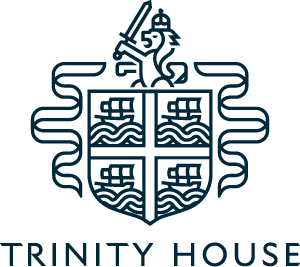
The Corporation of Trinity House of Deptford Strond, also known as Trinity House, is the official authority for lighthouses in England, Wales, the Channel Islands and Gibraltar. Trinity House is also responsible for the provision and maintenance of other navigational aids, such as lightvessels, buoys, and maritime radio/satellite communication systems. It is also an official deep sea pilotage authority, providing expert navigators for ships trading in Northern European waters.
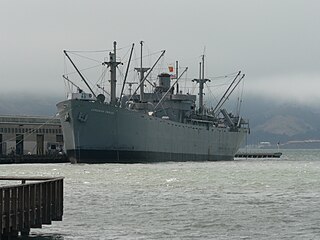
SS Jeremiah O'Brien is a Liberty ship built during World War II and named after the American Revolutionary War ship captain Jeremiah O'Brien (1744–1818).

Trinity Buoy Wharf is the site of a lighthouse, by the confluence of the River Thames and Bow Creek on the Leamouth Peninsula, Poplar. It lies within the London Borough of Tower Hamlets. The lighthouse no longer functions, but is the home of various art projects such as Longplayer. It is sometimes known as Bow Creek Lighthouse.

SS Robin is a 350 gross registered ton (GRT) steam coaster, a class of steamship designed for carrying bulk and general cargoes in coastal waters, and the oldest complete example in the world. One of a pair of coasters built in Bow Creek, London in 1890, the ship was built for British owners, but spent most of her long working life on the Spanish coast as Maria.
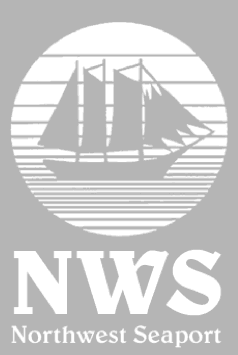
Northwest Seaport Maritime Heritage Center is a nonprofit organization in Seattle, Washington dedicated to the preservation and interpretation of Puget Sound and Northwest Coast maritime heritage, expressed through educational programs and experiences available to the public aboard its ships. The organization owns three large historic vessels docked at the Historic Ships' Wharf in Seattle's Lake Union Park; the tugboat Arthur Foss (1889), Lightship 83 Swiftsure (1904), and the halibut fishing schooner Tordenskjold (1911). These vessels are used as platforms for a variety of public programs, ranging from tours and festivals to restoration workshops and vocational training.

St Anne's Limehouse is a Hawksmoor Anglican Church in Limehouse, in the London Borough of Tower Hamlets. It was consecrated in 1730, one of the twelve churches built through the 1711 Act of Parliament.

The Museum of London Docklands, based in West India Quay, explains the history of the River Thames, the growth of Port of London and the docks' historical link to the Atlantic slave trade. The museum is part of the Museum of London and is jointly funded by the City of London Corporation and the Greater London Authority.
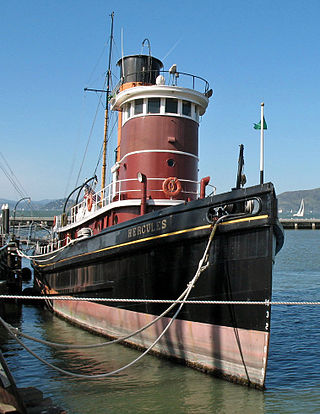
Hercules is a 1907-built steam tugboat that is now preserved at the San Francisco Maritime National Historical Park in San Francisco, California.

Eppleton Hall is a paddlewheel tugboat built in England in 1914. The only remaining intact example of a Tyne-built paddle tug, and one of only two surviving British-built paddle tugs, she is preserved at the San Francisco Maritime National Historical Park in San Francisco, California.

Pilot is a pilot boat and museum ship in San Diego, California. She was launched in 1914 in San Diego, built in the local boatyard of Manuel Goularte. She is a 52-foot wooden diesel powered vessel. She was the first powered pilot boat in San Diego. She served as the official pilot boat of San Diego Bay for 82 years, with no more than three consecutive days of downtime.

SS Foundation Franklin was a seagoing salvage tug built for the Royal Navy as HMS Frisky in 1918. In 1924, the tugboat was sold and renamed Gustavo Ipland before being acquired in 1930 by Foundation Maritime and renamed Foundation Franklin. The tugboat became famous for many daring salvage operations and rescues between 1930 and 1949. Her many rescues and salvage triumphs were celebrated in Farley Mowat's book The Grey Seas Under. In 1948, the ship was damaged in a hurricane and not considered repairable. The tug was broken up for scrap in 1949 at Halifax, Nova Scotia.

Massey Shaw is a former London Fire Brigade fireboat, named after the first Chief Officer of the Metropolitan Fire Brigade, Captain Sir Eyre Massey Shaw. Built in 1935 and decommissioned in 1971, the vessel was restored in the early 21st century and is moored in London's West India Docks.

Yankee is an early-20th-century steel hulled ferry which is registered as a historic vessel with the National Register of Historic Places. As of 2006 it was berthed in Hoboken, New Jersey. In mid-2013, the ferry was moved to the Henry Street pier in the Gowanus Bay Terminal in Red Hook, Brooklyn.

Edna G is a tugboat which worked the Great Lakes and is now preserved as a museum ship. Edna G was built by the Cleveland Shipbuilding Company in 1896 for the Duluth and Iron Range Railroad at a cost $35,397.50. She was named for the daughter of J. L. Greatsinger, president of the railroad.
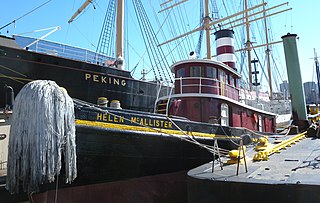
Admiral Dewey, also known as Georgetown and today as Helen McAllister, is a 113 feet (34 m) tugboat built in 1900 at the Burlee Drydock in Port Richmond, New York. She was built with a 900 horsepower (670 kW) triple expansion compound steam engine which was replaced with a diesel engine after World War II. She towed coal barges to refuel ships in the harbor. In 1955, she was sold to a Charleston, South Carolina tugboat company. In the 1980s, the McAllister tugboat company of New York purchased the company and brought the renamed Helen McAllister back to New York harbor. She helped dock tall ships during Op Sail 1992.

John H Amos is a paddlewheel tugboat built in Scotland in 1931. The last paddlewheel tug built for private owners, now owned by the Medway Maritime Trust. She is one of only two surviving British-built paddle tugs, the other being Eppleton Hall preserved at the San Francisco Maritime National Historical Park in San Francisco, California.

Standard Oil Company No. 16, later Pegasus, was a historic harbor tugboat located at Morris Canal Basin, Jersey City, New Jersey. She was built in 1907 by the Skinner Shipbuilding and Dry Dock Company of Baltimore, Maryland for the Standard Oil Company. She had heavy steel frames and deck beams. She was 100 feet in length, 23 feet in beam and 11.2 feet in depth. She was registered at 175 gross tons. She had an original wooden pilot house and the engine room dated to 1953-1954 when converted from steam to diesel. At that time, Standard Oil sold the tug to the McAllister Towing and Transportation Company and she was renamed McAllister 41. In 1955, she was renamed John E. McAllister.

Mayflower is a steam tug built in Bristol in 1861 and now preserved by Bristol Museums Galleries & Archives. She is based in Bristol Harbour at M Shed. She is the oldest Bristol-built ship afloat, and is believed to be the oldest surviving tug in the world.

Light Vessel 72 was a light vessel of Trinity House, a British lighthouse authority. Constructed in Sunderland in 1903 she served as a navigational beacon in the British Isles until the Second World War. From June 1944 she was positioned off Normandy to mark a mineswept shipping lane used for the Operation Overlord landings. After the war she was stationed in the Bristol Channel until sold for scrap in 1973. Saved by the intervention of a scrapyard manager, she has lain on a mud bank in Neath, Wales, ever since. Several proposals have been made to restore her.



















